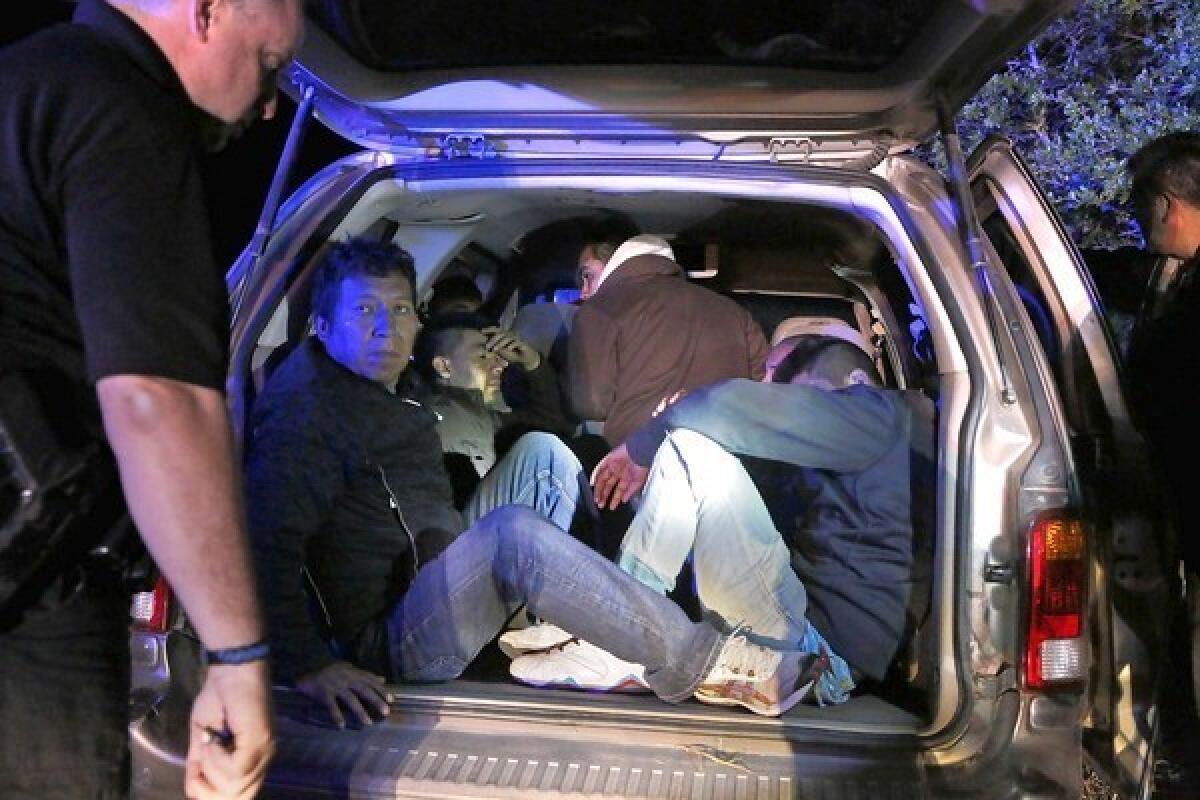In Mexico, U.S. border ‘surge’ proposal stirs outcry

- Share via
MEXICO CITY — The U.S. Senate’s proposal to spend $46 billion to help secure the country’s southern border may or may not persuade skeptical colleagues in the House to support broader immigration reform. But the proposal is generating some serious grumbling in Mexico.
“We are ‘friends and neighbors,’ as is repeated ad nauseam,” Fernando Belaunzaran, a congressman with Mexico’s left-wing Democratic Revolution Party, tweeted this week, “but the U.S. is about to militarize the border with Mexico as if we were at war.”
“Neighbors don’t do this to each other,” Univision news anchor Jorge Ramos wrote in the newspaper Reforma.
On a national radio show, Lorenzo Meyer, a respected columnist and academic, suggested that Mexico retaliate by kicking out CIA and Defense Department officials who are collaborating with the government in the fight against drug cartels. Or perhaps, Meyer mused, Mexico could get back at the U.S. by refusing to accept any more American retirees.
The proposed spending spree at the border — which supporters have labeled a “surge,” after the 2007 U.S. troop increase in Iraq — was included as an amendment to a broader immigration bill that appears almost certain to pass in the Senate this week. The additional spending would add nearly 20,000 Border Patrol officers, roughly doubling the current force. It would also fund the completion of 700 miles of border fencing and 24-hour surveillance flights by drones.
The Senate voted 67 to 27 on Monday to end debate on the amendment. Supporters are hoping that a lopsided approval of the immigration reform bill in the Senate will build momentum for the proposal as it heads to the House of Representatives.
In the lower chamber, some conservative lawmakers do not want to support the bill’s provision of a “path to citizenship” for unauthorized immigrants, particularly because they fear it will encourage more people to sneak in. But supporters of the surge are hoping to convince skeptical House members that slipping across the border will become far more difficult.
The plan’s American critics include immigrant rights advocates, budget hawks and civil libertarians wary of the expanded surveillance capabilities the Border Patrol would be granted. In Mexico, most of the complaints have come from the left, whose leaders have reiterated the long-held opinion here that U.S. border policy, with its walls, fences and armed border agents, is an insult to their nation.
A number of critics also have taken aim at the government of President Enrique Peña Nieto for not speaking out more forcefully.
“The passivity and negligence of his government is incomprehensible; it’s as if this had nothing to do with him, as if this was not going to seriously affect millions of Mexicans,” Ramos, the TV anchor, wrote in his column Sunday.
Peña Nieto’s team has chosen to hang back from the immigration debate north of the border, apparently out of fear that any cheerleading for the cause could be construed by American conservatives as unwarranted meddling. Former Mexican President Vicente Fox’s efforts to persuade Americans to accept immigration reform in 2001 led to a substantial backlash.
Fox’s former foreign secretary, Jorge Castañeda, who helped lobby for a change in immigration law in 2001, said the Mexican government needed to speak out about the plan.
“Mexico can’t say nothing in the face of a reform that includes doubling the number of Border Patrol agents,” he said in a radio interview Monday. “It strikes me as shameful.”
On Tuesday, Foreign Secretary Jose Antonio Meade delivered a measured statement in which he reiterated the government’s contention that U.S. immigration reform would help millions of Mexican migrants.
But fences, Meade said, “are not the solution to the phenomenon of migration, and aren’t consistent with a modern and secure border. They don’t contribute to the development of the competitive region that both countries seek to promote.”
The apprehension of Mexicans at the U.S. border has been trending dramatically downward since fiscal 2000, when 1.6 million Mexicans were detained. In fiscal 2012, the number was 262,000. It’s likely that fewer Mexicans have been trying to cross in light of the sputtering U.S. economy, stricter border control and fear of Mexican criminals who prey on migrants.
U.S. government statistics show that the number of non-Mexicans apprehended at the border, most of whom were Central Americans, also declined from fiscal 2005 to 2011. But the number doubled from 2011 to 2012, to 94,000, probably a result of rising violence and instability in several Central American countries.
Maria Garcia, the president of the Mexico City-based Aztlan Binational Migrants Movement, said that increased border enforcement would force migrants to find even more dangerous and remote places to cross the border, putting their lives at greater risk. She also doubted that a more heavily fortified border would do much to scare off migrants seeking better wages.
“Hunger is too strong,” she said. “They’ll keep risking their lives.”
But Alfredo Rodriguez, a 59-year-old hardware store clerk, said he could live with the border plan if the U.S. gave Mexicans more legal avenues for employment, such as temporary work visas. In any case, he said, the Americans were within their rights to beef up their security.
“If you invade someone’s property,” he said, “obviously, there are going to be consequences.”
More to Read
Sign up for Essential California
The most important California stories and recommendations in your inbox every morning.
You may occasionally receive promotional content from the Los Angeles Times.










